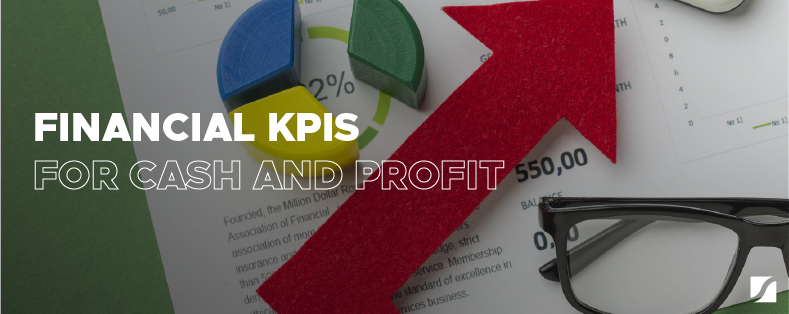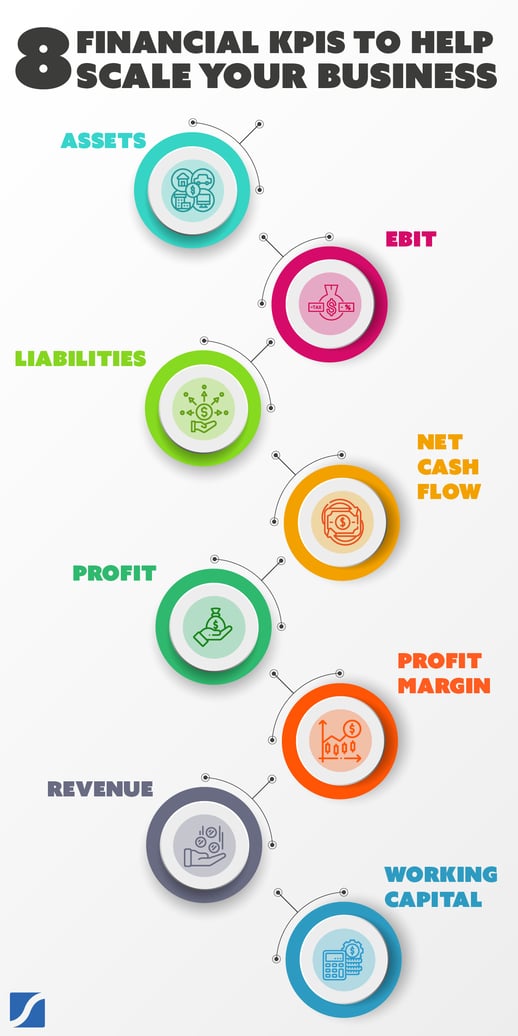Which Financial KPIs Are Most Important For Your Company?


The U.S. Small Business Administration reports that only about half of American companies survive five years. That number drops to about a third of companies after 10 years.
Financing plays a critical role in determining whether your business will be among those that are thriving years into the future. Done right, your financing will not only fund your day-to-day operations, but it also will inform them.
That’s why I believe you and your team need to understand the story of your company’s finances.
How do you measure the financial health of your business? It starts with knowing and tracking your financial key performance indicators (KPIs)—and understanding which of those KPIs should command the greatest interest. If you’re an entrepreneur, CEO, or other executive-level leader, the importance of financial KPIs won’t come as a surprise to you.
So which KPIs are the most important for you to track? Let's dig in.
Financial KPIs Can Help Your Company Scale
KPIs are quantifiable measurement tools that inform your progress toward your vision as a company.
Cash flow is your company’s most important financial KPI, but it’s not the only one you need to track. Let’s start by taking a look at 8 of the critical KPIs that go into evaluating your company’s financial health and planning its future. Then we’ll dive into how those KPIs can drive measures to increase cash, build profit, and save time.
Assets
Assets are resources that your company owns or controls to provide a future benefit. Reported on a balance sheet, assets refer to items that could generate cash, reduce expenses, or improve sales.
EBIT
EBIT is an acronym for earnings before interest and taxes. Also referred to as operating profit, EBIT is a gauge of your business’ profitability. To calculate this KPI, figure revenue minus expenses excluding tax and interest.
Liabilities
Total liabilities refers to the debts and obligations your organization owes to other entities. Also displayed on a balance sheet, classifications of liabilities include short-term, long-term, and other.
Net Cash Flow
Cash flow is the movement of money in all your business’ bank accounts in any time period, or everything transferring in and out of your accounts. To calculate your net cash flow, add or subtract your profit, working capital, and other capital.
Profit
Profit occurs when your company’s revenue exceeds expenses, costs, and taxes. Operating profit is your profit before taxes and dividends, and net profit is the amount after taxes and dividends.
Profit Margin
Expressed as a percentage, profit margin shows how many cents of profit your company generates for each dollar of goods or services it sells. Find this KPI by dividing income—or the money your business makes for providing a product or service—by revenues.
Revenue
Also known as sales or top line, revenue is the money generated from the sale of your products and services. Calculate this figure as the average sales price times the number of units sold.
Working Capital
Working capital includes factors such as payables, receivables, and inventory. It represents capital that remains after subtracting your accounts payable from the total of your inventory and accounts receivable, or the balance due from customers.
A Critical Financial KPI: Your Cash Flow
So, yes, revenue is among the critical financial KPIs, as is profit. But when it comes to scaling you're business, they’re not as important as their less glamorous cousin, cash flow.
My favorite saying is: Revenue is vanity, profit is sanity, and cash is king or queen.
After all, when you scale, you take on new systems and processes—and, if you’re not careful, those costs can quickly become your company’s undoing. Even if your profits and revenue show healthy financial growth, that may be because you have more expenses. Considered alone, revenue and profits don’t reflect the financial reality of your business.
As the movement of money in all your business’ bank accounts, cash flow includes payments your company receives for products and services as well as the payments it makes to vendors, suppliers, and creditors.
Let’s say, for example, you start the year with $10,000 in the bank and end it with $1,000 left in your bank. Your cash flow is -$9,000.
To fuel your company’s growth, you need access to cash. You also need to understand where changes as small as 1% can yield financial gains. That means you need to understand where you stand in your company’s Cash Flow Story.
4 Chapters Tell Your Company’s Cash Flow Story
I like to say that a business is like reading a murder mystery.
Think about the first chapter of that book. It’s just the start of the journey to learning who committed the crime. Your organization’s financial story is no different. You need to understand the entire narrative, which in the case of your business includes Four Chapters—and involves a host of critical KPIs.
The result of the KPIs in the first 3 chapters lead you to your fourth chapter.
Chapter 2: Working Capital. The next chapter shows how much capital remains after subtracting your accounts payable from the total of your inventory and accounts receivable.
Chapter 3: Other Capital. This chapter includes KPIs related to any additional assets, such as fixed assets and investments, accruals, and prepayments.
Chapter 4: Net Cash Flow. This final chapter represents the number you get when you add or subtract the figures from your first 3 chapters. Here’s where you learn whether you are in positive cash flow or if you need funding to finance your growth.
%20(1).jpeg?width=864&name=cash%20flow%20the%204%20chapters%20(1)%20(1).jpeg)
Balance Sheets Reveal Important KPIs
The KPIs that tell your Cash Flow Story go beyond those on your Profit and Loss (P&L) statement. Sure, profit is among the list of most valuable KPIs, but you can be profitable without having a positive cash flow.
Review your balance sheet to see a snapshot of your company’s assets and liabilities at any time. Here, in the most basic terms, is what you’ll see: Your funding must equal your operations.
The amount of funding you have includes the equity you hold—or the difference between the value of your assets and its liabilities—and the debts you owe. Operational numbers include working capital—such as payables, receivables, and inventory—as well as other numbers such as land and buildings you hold.
When you add or subtract money from the funding side, it shows up on the operational side. And, if you subtract or add money on the operational side, it shows up on the funding side.
They balance.
As you explore the KPIs on your balance sheet, keep in mind that the figures that comprise working capital—payables, receivables, and inventory—are in constant flux. And that means your management team can take simple actions to change your Cash Flow Story.
How To Improve Your Cash Flow With The Power of 1%
So, understanding your KPIs—and most importantly, your cash flow—not only helps you gauge your company’s financial health, but it also can serve as an indicator of the effectiveness of your management activities. Consistent and careful evaluation of cash flow can help you understand which management decisions will have a positive impact on your cash flow.
Each month, gather your team to do a quick calculation of your net cash flow. Look at changes to bank account balances, plus or minus any loans or debts, and the changes in the amounts you owe on them. Evaluate ways your management team can improve your working capital KPIs.
A 1% or 1-day change to rates can improve your cash flow. You can make these 1% adjustments in any of the following 7 areas:
- Price. Increase the price of your products or services.
- Volume. Sell more of the product or service you provide.
- Cost of goods sold (COGS)/direct costs. Lower the price you pay for raw materials and labor by focusing on lean initiatives
- Operating expenses. Lower operating costs, and reduce sales cycles using Victoria Medvec’s negotiation tools.
- Accounts receivable. Reduce the amount of time it takes for customers to pay.
- Inventory/work in progress. Lower the amount of inventory your business has on hand.
- Accounts payable. Seek to extend the time by which you pay your creditors.
If you need help determining which of these areas will have the most dramatic impact on your organization’s cash flow, download my Power of One Tool and plug in your EBIT and net cash flow numbers.
2X Cash, 3x Profit, And Save Time
Now you’ve learned about critical financial KPIs, the value of cash flow, and the way your balance sheet can inform your management activities. If you’re ready to put your KPIs to work to help you evaluate and enhance your company’s prospects for success in 2022 and beyond, please join me for a live training at 4 p.m. ET on Jan. 18, 2022.
We’ll explore how making 1% changes can help your company:
- Increase its cash flow
- Improve its cash conversion cycle
- Learn when and where to spend
- Enhance its value




